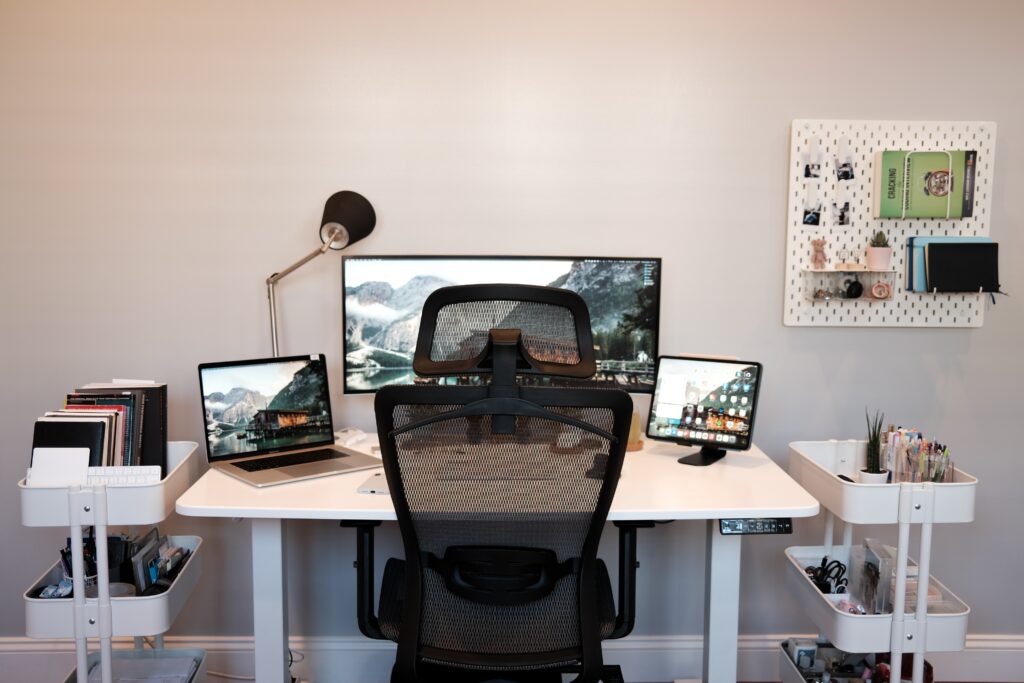
Creating an Ergonomic Standing Desk Setup: A Step-by-Step Guide
| Section | Main Key Point |
|---|---|
| Step 1: Assess Your Workspace | Begin by assessing your workspace, taking into account factors like space, lighting, noise, and ventilation. |
| Step 2: Choose the Right Desk | Select the right standing desk based on your needs, considering factors like adjustability, size, and weight capacity. |
| Step 3: Select an Ergonomic Chair | Choose an ergonomic chair with features like lumbar support, height adjustability, and swivel capabilities. |
| Step 4: Position Your Monitor | Properly position your monitor to prevent neck strain and ensure wrist and hand alignment with keyboard and mouse. |
| Step 5: Arrange Essential Supplies | Use an anti-fatigue mat and footrests to enhance comfort during prolonged standing periods. |
| Step 6: Cable Management | Organize cables using clips, ties, and cable trays to improve safety, aesthetics, and workflow. |
| Step 7: Customize for Your Body | Fine-tune your setup to match your body’s proportions and ensure comfort. |
| Step 8: Integrate Movement | Incorporate movement breaks, stretches, and walks to reduce muscle fatigue and boost energy. |
| Step 9: Evaluate and Refine | Regularly assess and make adjustments to your setup as needed, seeking professional advice if necessary. |
Introduction
Welcome to our step-by-step guide to crafting the ultimate ergonomic standing desk set up. If you’re on a quest for comfort and productivity, you’re in the right place. Furthermore, we’ve done in-depth research and have had a great deal of experience perfecting ergonomic office spaces, and we’re thrilled to share our insights with you. An ergonomic standing desk set up isn’t just about aesthetics; it’s about creating a workspace that supports your body, boosts your energy, and helps you accomplish more throughout the day. So, let’s dive in and create your perfect standing desk set up!
Step 1: Assess Your Workspace
Before you dive into selecting furniture and accessories, take a moment to assess your workspace. Firstly, consider factors like the available space, lighting, noise level, and ventilation. An organized and serene workspace can have a profound impact on your focus and well-being. Additionally, remember that your workspace should be tailored to your needs and preferences.
Step 2: Choose the Right Standing Desk
Ergonomic standing desks come in various types, each with its own set of benefits. Manual desks offer simplicity and reliability, electric desks provide easy adjustability, and converters transform your existing desk into a standing one. Consider the desk’s adjustability range, size, and weight capacity. If you’re like one of our team members who swears by the electric standing desk’s flexibility, you’ll appreciate the ease of changing heights throughout the day.

If you’ve already decided on getting a desk, check out our comprehensive guide on some of the most affordable sit-stand desks you can get right now: Affordable Standing Desks in 2023 and if you’re looking for space saving standing desks check out here!
Step 3: Select an Ergonomic Chair
The right chair complements your ergonomic standing desk set up by providing support during sitting breaks. It’s essential to look for features like lumbar support, adjustable height, and swivel capabilities. Consequently, many individuals have learned this lesson the hard way when their old and stiff chairs lead to back pain. Switching to an ergonomic chair can help improve comfort drastically. To gain more insights on maintaining proper posture, we invite you to explore our guide on Office Chair Posture.
| Ergonomic Chair Model | Brand | Approximate Price (USD) |
|---|---|---|
| Herman Miller Aeron | Herman Miller | $600-$900 |
| Steelcase Gesture | Steelcase | $1,000 – $1,300 |
| Steelcase Leap | Steelcase | $900 – $1,200 |
| Secretlab Omega Series | Secretlab | $350 – $700 |
| Autonomous ErgoChair 2 | Autonomous | $300 – $500 |
| Ikea Markus | IKEA | $200 – $500 |
| HON Ignition 2.0 (Amazon’s Overall Pick) | HON | $300 – $400 |
| La-Z-Boy Bellamy | La-Z-Boy | $300 – $400 |
| AmazonBasics Mid-Back Mesh | AmazonBasics | $80 – $150 |
Step 4: Position Your Monitor and Accessories
A monitor’s positioning is crucial to prevent neck strain. It’s essential to position the top of the screen at eye level and maintain a distance of an arm’s length away. Additionally, consider investing in a monitor arm for easy adjustment. Furthermore, keyboard trays and mouse pads play pivotal roles in ensuring proper wrist and hand alignment. As a result, many people find that wrist discomfort vanishes once they make the adjustment to ergonomic keyboard and mouse heights.
Step 6: Arrange Essential Supplies
Standing for extended periods can take a toll on your feet. That’s why incorporating an anti-fatigue mat is essential, as it provides cushioning and encourages subtle movement to alleviate pressure. Moreover, don’t forget about footrests, which are instrumental in promoting healthy posture.
To decide on whether anti-fatigue mats are worth your investment, check out here: Are Anti-Fatigue Mats Worth It?
Step 7: Cable Management and Organization
An organized workspace is a happy workspace. In addition to enhancing aesthetics, it’s crucial for safety. Tangled cables not only look unsightly but also pose a safety hazard. Therefore, utilize clips, ties, and cable trays to keep things tidy and secure. Many people can recall a time when cables caused a minor accident, which has led them to embrace cable management wholeheartedly. As a result, investing in cable management is a relatively inexpensive way to improve safety, aesthetics, and workflow.
Step 8: Customize for Your Body
Everybody is different, so it’s essential to take the time to fine-tune your setup. Be sure to adjust your desk height, chair settings, and monitor angles to match your body’s unique proportions. Keep in mind that comfort is paramount. Many individuals invest days in finding optimal settings, and it may take a bit of time to discover the perfect setup that allows for pain-free workdays.
Step 9: Integrate Movement
Ergonomic setups don’t mean you have to stand like a statue. In fact, movement is key to reducing muscle fatigue. Remember to take standing breaks, engage in stretches, and even go for short walks. It’s highly advisable to incorporate quick stretches every hour, as doing so can result in a remarkable increase in energy levels.
Creating an ergonomic workspace isn’t about being static; it’s about promoting flexibility. Therefore, don’t feel compelled to remain in one position for extended periods. Click here if you want an in depth guide of what we consider to be the best affordable under the desk treadmills.
Stretches to Incorporate
| Stretch Exercise | How It Helps |
|---|---|
| Neck Stretch | Relieves tension in the neck and shoulders, reduces neck and upper back pain. |
| Shoulder Rolls | Eases shoulder stiffness, enhances blood circulation, and reduces tension in the upper body. |
| Seated Spinal Twist | Improves spinal flexibility, reduces lower back discomfort, and enhances posture. |
| Wrist and Finger Stretch | Relieves wrist and hand strain caused by typing or using a mouse for an extended period. |
| Cat-Cow Stretch (Seated) | Promotes flexibility in the spine, alleviates lower back discomfort, and reduces stiffness. |
| Hip Flexor Stretch (Standing) | Helps prevent hip flexor tightness, enhances hip mobility, and reduces lower back strain. |
| Standing Forward Fold | Relieves tension in the lower back, stretches the hamstrings, and increases blood flow to the brain. |
| Quad Stretch (Standing) | Reduces tightness in the quadriceps, eases hip discomfort, and enhances overall leg flexibility. |
| Calf Stretch (Standing) | Prevents calf muscle tightness, improves lower leg circulation, and reduces leg fatigue. |
| Ankle Circles (Seated or Standing) | Increases ankle flexibility, reduces ankle stiffness, and improves blood flow to the lower legs. |
Step 10: Evaluate and Refine
Creating your ergonomic standing desk set up is not a one-and-done task. Regularly assess your comfort and productivity. Moreover, as your needs evolve, make adjustments accordingly. Don’t hesitate to seek advice from professionals if you encounter challenges.
Conclusion
You’ve embarked on a journey to create a workspace that supports your well-being and productivity. First and foremost, remember that an ergonomic standing desk set up is a dynamic concept that evolves with you. Additionally, by following our step-by-step guide, infused with personal anecdotes and lessons learned, you’re well-equipped to craft a workspace that’s uniquely tailored to you. Your body will thank you, and your productivity will soar. So, here’s to a healthier and happier work environment!
Frequently Asked Questions (FAQ)
An ergonomic standing desk set up is crucial because it helps create a workspace that supports your body, boosts energy, and enhances productivity. It’s not just about aesthetics; it’s about ensuring comfort and well-being throughout your workday.
To assess your workspace, consider factors such as available space, lighting, noise level, and ventilation. An organized and serene workspace can significantly impact your focus and overall well-being.
There are various types of ergonomic standing desks, including manual desks for simplicity and reliability, electric desks for easy adjustability, and converters that transform your existing desk into a standing one. Choose based on your preferences and needs.
When selecting an ergonomic chair, look for features such as lumbar support, adjustable height, and swivel capabilities. A good chair complements your standing desk by providing support during sitting breaks and improving overall comfort.
Position your monitor with the top of the screen at eye level and at an arm’s length away to prevent neck strain. Consider using a monitor arm for easy adjustment. Additionally, ensure proper wrist and hand alignment with ergonomic keyboard trays and mouse pads.
Additional Resources
- The Ergonomics Society – Visit the official website of The Ergonomics Society for a wealth of information on ergonomics, including research papers, articles, and guidelines for creating ergonomic workspaces. The Ergonomics Society
- OSHA’s Ergonomics eTool – The Occupational Safety and Health Administration (OSHA) provides a comprehensive eTool on ergonomics, offering guidelines and solutions to reduce ergonomic-related injuries in the workplace. OSHA Ergonomics eTool
- Mayo Clinic – Office Ergonomics: Your How-To Guide – Mayo Clinic offers a practical guide to office ergonomics, covering desk setup, chair selection, and tips for maintaining a comfortable and healthy workspace. Mayo Clinic Office Ergonomics Guide
- Digital Marketing Tools: The Importance of Marketing Tools
 The Importance of Marketing Tools In today’s digital landscape, businesses …
The Importance of Marketing Tools In today’s digital landscape, businesses …Digital Marketing Tools: The Importance of Marketing Tools Read More »
- A Guide to Fundamental Marketing Tools for Businesses
 What are marketing tools? At Opvital, we’re dedicated to shedding …
What are marketing tools? At Opvital, we’re dedicated to shedding …A Guide to Fundamental Marketing Tools for Businesses Read More »
- The Significance of Marketing Tools
 Key Takeaways for Marketing Tools Marketing Tools Overview – Diverse …
Key Takeaways for Marketing Tools Marketing Tools Overview – Diverse … - A Comprehensive NeuronWriter Review: Unveiling Its SEO Powers
 Welcome to Opvital’s in depth NeuronWriter Review. NeuronWriter is more …
Welcome to Opvital’s in depth NeuronWriter Review. NeuronWriter is more …A Comprehensive NeuronWriter Review: Unveiling Its SEO Powers Read More »
